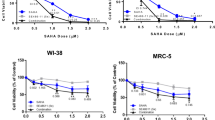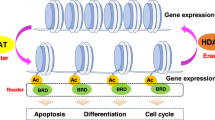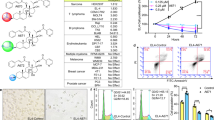Abstract
Oxamflatin [(2E) - 5 - [3 - [(phenylsufonyl) amino] phenyl]-pent-2-en-4-ynohydroxamic acid] induces transcriptional activation of junD and morphological reversion in various NIH3T3-derived transformed cell lines. We found that oxamflatin showed in vitro antiproliferative activity against various mouse and human tumor cell lines with drastic changes in the cell morphology and in vivo antitumor activity against B16 melanoma. Oxamflatin caused an elongated cell shape with filamentous protrusions as well as arrest of the cell cycle at the G1 phase in HeLa cells. These phenotypic changes of HeLa cells were apparently similar to those by trichostatin A (TSA), a specific inhibitor of histone deacetylase (HDAC). The effect of oxamflatin on the transcriptional activity of the cytomegalovirus (CMV) promoter was examined and compared with known HDAC inhibitors, TSA, sodium n-butyrate, and FR901228. Oxamflatin as well as all these inhibitors greatly enhanced the transcriptional activity of the CMV promoter in a dose-dependent manner. Oxamflatin, like TSA, inhibited intracellular HDAC activity, as a result of which marked amounts of acetylated histone species accumulated. Finally, effects on expression of several endogenous genes involved in cell morphology and cell cycle control in HeLa cells were analysed. Expression of gelsolin, cyclin E and Cdk inhibitors including p21WAF1/Cip1 was highly augmented, while that of cyclin A and cyclin D1 was decreased by oxamflatin. These results suggest that changes in the expression pattern of the genes regulating cell morphology and the cell cycle due to histone hyperacetylation are responsible for the antitumor activity, the morphological change and the cell cycle arrest induced by oxamflatin.
This is a preview of subscription content, access via your institution
Access options
Subscribe to this journal
Receive 50 print issues and online access
$259.00 per year
only $5.18 per issue
Buy this article
- Purchase on Springer Link
- Instant access to full article PDF
Prices may be subject to local taxes which are calculated during checkout





Similar content being viewed by others
References
Ayer DE, Lawrence QA and Eisenman RN. . 1997 Cell 80: 767–776.
Bannister AJ and Kouzarides T. . 1996 Nature 384: 641–643.
Brehm A, Miska EA, McCance DJ, Reid JL, Bannister AJ and Kouzarides T. . 1998 Nature 391: 597–601.
Brownell JE, Zhou J, Ranalli T, Kobayashi R, Edmondson DG, Roth SY and Allis CD. . 1996 Cell 84: 843–851.
Chaponnier C and Gabbiani G. . 1989 Am. J. Pathol. 134: 597–603.
Chen JY, Penco S, Ostrowski J, Balaguer P, Pons M, Starrett JE, Reczek P, Chambon P and Gronemeyer H. . 1995 EMBO J. 14: 1187–1197.
Chen WY, Bailey EC, McCune SL, Dong JY and Townes TM. . 1997 Proc. Natl. Acad. Sci. USA 94: 5798–5803.
Cousens LS, Gallwitz D and Alberts BM. . 1979 J. Biol. Chem. 254: 1716–1723.
Cunningham CC, Stossel TP and Kwiatkowski DJ. . 1991 Science 251: 1233–1236.
Dion LD, Goldsmith KT, Tang D-c, Engler JA, Yoshida M and Garver Jr RI. . 1997 Virology 231: 201–209.
Fallon RJ and Cox RP. . 1979 J. Cell. Physiol. 100: 251–262.
Futamura M, Monden Y, Okabe T, Fujita YJ, Yokoyama S and Nishimura S. . 1995 Oncogene 10: 1119–1123.
Golberg YP, Leaner VD and Parker MI. . 1992 J. Cell. Biochem. 49: 74–81.
Grunstein M. . 1997 Nature 389: 349–352.
Hassig CA, Fleischer TC, Billin AN, Schreiber SL and Ayer DE. . 1997 Cell 89: 341–347.
Hassig CA, Tong JK, Fleischer TC, Owa T, Grable PG, Ayer DE and Schreiber SL. . 1998 Proc. Natl. Acad. Sci. USA 95: 3519–3524.
Hoshikawa Y, Kwon HJ, Yoshida M, Horinouchi S and Beppu T. . 1994 Exp. Cell Res. 214: 189–197.
Inagaki M, Watanabe M and Hidaka H. . 1985 J. Biol. Chem. 260: 2922–2925.
Inoue A and Fujimoto D. . 1970 Biochim. Biophys. Acta 220: 307–316.
Itazaki H, Nagashima K, Sugita K, Yoshida H, Kawamura Y, Yasuda Y, Matsumoto K, Ishii K, Uotani N, Nakai H, Terui A, Yoshimatsu S, Ikenishi Y and Nakagawa Y. . 1990 J. Antibiot. 43: 1524–1532.
Kadosh D and Struhl K. . 1997 Cell 89: 365–371.
Kamb A, Gruis NA, Weaver FJ, Liu Q, Harshman K, Tavtigian SV, Stockert E, Day RIII, Johnson BE and Skolnick MH. . 1994a Science 264: 436–440.
Kamb A, Shattuck ED, Eeles R, Liu Q, Gruis NA, Ding W, Hussey C, Tran T, Miki Y, Weaver FJ and et al. 1994b Nature Genet. 8: 23–26.
Khochbin S and Wolffe AP. . 1997 FEBS Lett. 419: 157–160.
Kijima M, Yoshida M, Sugita K, Horinouchi S and Beppu T. . 1993 J. Biol. Chem. 268: 22429–22435.
Kothakota S, Azuma T, Reinhard C, Klippel A, Tang J, Chu K, McGarry TJ, Kirschner MW, Koths K, Kwiatkowski DJ and Williams LT. . 1997 Science 278: 294–298.
Kwon HJ, Owa T, Hassig CA, Shimada J and Schreiber SL. . 1998 Proc. Natl. Acad. Sci. USA 95: 3356–3361.
Kwon HJ, Yoshida M, Nagaoka R, Obinata T, Beppu T and Horinouchi S. . 1997 Oncogene 15: 2625–2631.
Laherty CD, Yang WM, Sun JM, Davie JR, Seto E and Eisenman RN. . 1997 Cell 89: 349–356.
Magnaghi JL, Groisman R, Naguibneva I, Robin P, Lorain S, Le VJ, Troalen F, Trouche D and Harel BA. . 1998 Nature 391: 601–605.
Mizzen CA, Yang X-J, Kokubo T, Brownell JE, Workman A, Wang L, Berger SL, Kouzarides T, Nakatani Y and Allis CD. . 1996 Cell 87: 1261–1270.
Moriya S, Yanagihara K, Fujita H and Kuzumaki N. . 1996 Cell 87: 1261–1270.
Moriya S, Yanagihara K, Fujita H and Kuzumaki N. . 1994 Int. J. Oncol. 5: 1347–1351.
Mosmann T. . 1983 J. Immunol. Methods 65: 2180–2184.
Müllauer L, Fujita H, Ishizaki A and Kuzumaki N. . 1993 Oncogene 8: 2531–2536.
Nagy L, Kao HY, Chakravarti D, Lin RJ, Hassig CA, Ayer DE, Schreiber SL and Evans RM. . 1997 Cell 89: 373–380.
Nakajima H, Kim YB, Terano H, Yoshida M and Horinouchi S. . 1998 Exp. Cell Res. 241: 126–133.
Nobori T, Miura K, Wu DJ, Lois A, Takabayashi K and Carson DA. . 1994 Nature 368: 753–756.
Noguchi PD and Browne WC. . 1978 J. Histochem. Cytochem. 26: 761–763.
Ogryzko VV, Schitz RL, Russanova V, Howard BH and Nakatani Y. . 1996 Cell 87: 953–959.
Pazin MJ and Kadonaga JT. . 1997 Cell 89: 325–328.
Petrij F, Giles RH, Dauwerse HG, Saris JJ, Hennekam RCM, Masuno M, Tommerup N, van Ommen G-JB, Goodman RH, Peters DJM and Breuning MH. . 1995 Nature 376: 348–351.
Porter RM, Holme TC, Newman EL, Hopwood D, Wilkinson JM and Cuschieri A. . 1993 J. Pathol. 170: 435–440.
Sherr CJ. . 1993 Cell 73: 1059–1065.
Sherr CJ. . 1994 Cell 79: 551–555.
Siddique H, Zou JP, Rao VN and Reddy ES. . 1998 Oncogene 16: 2283–2285.
Sonoda H, Nishida K, Yoshioka T, Ohtani M and Sugita K. . 1996 Oncogene 13: 143–149.
Sowa Y, Orita T, Minamikawa S, Nakano K, Mizuno T, Nomura H and Sakai T. . 1997 Biochem. Biophys. Res. Commun. 241: 142–150.
Sugita K, Koizumi K and Yoshida H. . 1992 Cancer Res. 52: 168–172.
Supuran CT, Briganti F and Scozzafava A. . 1997 J. Enzyme Inhib. 12: 175–190.
Tamura Y, Watanabe F, Nakatani T, Yasui K, Fuji M, Komurasaki T, Tsuzuki H, Maekawa R, Yoshioka T, Kawada K, Sugita K and Ohtani M. . 1998 J. Med. Chem. 41: 640–649.
Tanaka J, Sadanari H, Sato H and Fukuda S. . 1991 Virology 185: 271–280.
Tanaka M, Müllauer L, Ogiso Y, Fujita H, Moriya S, Furuuchi K, Harabayashi T, Shinohara N, Koyanagi T and Kuzumaki N. . 1995 Cancer Res. 55: 3228–3232.
Taunton J, Hassig CA and Schreiber SL. . 1996 Science 272: 408–411.
Ueda H, Manda T, Matsumoto S, Mukumoto S, Nishigaki F, Kawamura I and Shimomura K. . 1994a J. Antibiot. 47: 315–323.
Ueda M, Nakajima H, Hori Y, Fujita T, Nishimura M, Goto T and Okuhara M. . 1994b J. Antibiot. 47: 301–310.
Van Lint C, Emiliani S and Verdin E. . 1996 Gene Expr. 5: 245–253.
Vandekerckhove J, Bauw G, Vancompernolle K, Honoré B and Celis J. . 1990 J. Cell Biol. 111: 95–102.
Wade PA, Pruss D and Wolffe AP. . 1997 Trends Biochem. Sci. 22: 128–132.
Wolffe AP. . 1996 Science 272: 371–372.
Yang W, Inouye C, Zeng Y, Bearss D and Seto E. . 1996a Proc. Natl. Acad. Sci. USA 93: 12845–12850.
Yang XJ, Ogryzko VV, Nishikawa J, Howard BH and Nakatani Y. . 1996b Nature 382: 319–324.
Yoshida M and Beppu T. . 1988 Exp. Cell. Res. 177: 122–131.
Yoshida M, Horinouchi S and Beppu T. . 1995 BioEssays 17: 423–430.
Yoshida M, Kijima M, Akita M and Beppu T. . 1990 J. Biol. Chem. 265: 17174–17179.
Acknowledgements
We would like to thank D Kasuga, Tokyo Medical and Dental University for the gift of the cell lines. We are grateful to H Nakajima and K Shimomura, Fujisawa Pharmaceutical Co. Ltd., for providing us with FR901228. We would also like to thank SW Ki and S Akakura, the University of Tokyo, for helpful advice and discussion. This work was supported in part by a special grant for Advanced Research on Cancer from the Ministry of Education, Culture and Science of Japan to MY. YBK was supported by a scholarship from the Park Yong Koo Scholarship Foundation.
Author information
Authors and Affiliations
Rights and permissions
About this article
Cite this article
Kim, Y., Lee, KH., Sugita, K. et al. Oxamflatin is a novel antitumor compound that inhibits mammalian histone deacetylase. Oncogene 18, 2461–2470 (1999). https://doi.org/10.1038/sj.onc.1202564
Received:
Revised:
Accepted:
Published:
Issue Date:
DOI: https://doi.org/10.1038/sj.onc.1202564
Keywords
This article is cited by
-
A novel chemical-combination screen in zebrafish identifies epigenetic small molecule candidates for the treatment of Duchenne muscular dystrophy
Skeletal Muscle (2020)
-
RETRACTED ARTICLE: MicroRNA-30c-regulated HDAC9 mediates chemoresistance of breast cancer
Cancer Chemotherapy and Pharmacology (2020)
-
Targeting epigenetic regulators for cancer therapy: mechanisms and advances in clinical trials
Signal Transduction and Targeted Therapy (2019)
-
Chemogenomic analysis reveals key role for lysine acetylation in regulating Arc stability
Nature Communications (2017)
-
The effect of oxamflatin on the E-cadherin expression in gastric cancer cell line
Cancer Gene Therapy (2016)



